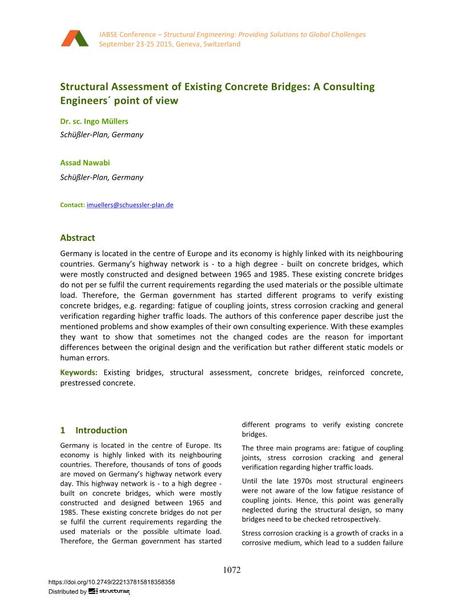Structural Assessment of Existing Concrete Bridges: A Consulting Engineers´ point of view

|
|
|||||||||||
Bibliografische Angaben
| Autor(en): |
Ingo Müllers
(Schüßler-Plan, Germany)
Assad Nawabi (Schüßler-Plan, Germany) |
||||
|---|---|---|---|---|---|
| Medium: | Tagungsbeitrag | ||||
| Sprache(n): | Englisch | ||||
| Tagung: | IABSE Conference: Structural Engineering: Providing Solutions to Global Challenges, Geneva, Switzerland, September 2015 | ||||
| Veröffentlicht in: | IABSE Conference Geneva 2015 | ||||
|
|||||
| Seite(n): | 1072-1079 | ||||
| Anzahl der Seiten (im PDF): | 8 | ||||
| Jahr: | 2015 | ||||
| DOI: | 10.2749/222137815818358358 | ||||
| Abstrakt: |
Germany is located in the centre of Europe and its economy is highly linked with its neighbouring countries. Germany’s highway network is - to a high degree - built on concrete bridges, which were mostly constructed and designed between 1965 and 1985. These existing concrete bridges do not per se fulfil the current requirements regarding the used materials or the possible ultimate load. Therefore, the German government has started different programs to verify existing concrete bridges, e.g. regarding: fatigue of coupling joints, stress corrosion cracking and general verification regarding higher traffic loads. The authors of this conference paper describe just the mentioned problems and show examples of their own consulting experience. With these examples they want to show that sometimes not the changed codes are the reason for important differences between the original design and the verification but rather different static models or human errors. |
||||
| Stichwörter: |
Stahlbeton Betonbrücke
|
||||
